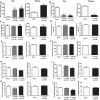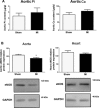Experimental Myocardial Infarction Upregulates Circulating Fibroblast Growth Factor-23
- PMID: 25858796
- PMCID: PMC4973700
- DOI: 10.1002/jbmr.2527
Experimental Myocardial Infarction Upregulates Circulating Fibroblast Growth Factor-23
Abstract
Myocardial infarction (MI) is a major cause of death worldwide. Epidemiological studies have linked vitamin D deficiency to MI incidence. Because fibroblast growth factor-23 (FGF23) is a master regulator of vitamin D hormone production and has been shown to be associated with cardiac hypertrophy per se, we explored the hypothesis that FGF23 may be a previously unrecognized pathophysiological factor causally linked to progression of cardiac dysfunction post-MI. Here, we show that circulating intact Fgf23 was profoundly elevated, whereas serum vitamin D hormone levels were suppressed, after induction of experimental MI in rat and mouse models, independent of changes in serum soluble Klotho or serum parathyroid hormone. Both skeletal and cardiac expression of Fgf23 was increased after MI. Although the molecular link between the cardiac lesion and circulating Fgf23 concentrations remains to be identified, our study has uncovered a novel heart-bone-kidney axis that may have important clinical implications and may inaugurate the new field of cardio-osteology.
Keywords: FGF23; MYOCARDIAL INFARCTION; VITAMIN D.
© 2015 American Society for Bone and Mineral Research.
Figures






References
-
- Scragg R, Sowers M, Bell C. Serum 25‐hydroxyvitamin D, ethnicity, and blood pressure in the Third National Health and Nutrition Examination Survey. Am J Hypertens. 2007; 20:713–9. - PubMed
-
- Judd SE, Nanes MS, Ziegler TR, et al. Optimal vitamin D status attenuates the age‐associated increase in systolic blood pressure in white Americans: results from the third National Health and Nutrition Examination Survey. Am J Clin Nutr. 2008; 87:136–41. - PubMed
Publication types
MeSH terms
Substances
Grants and funding
LinkOut - more resources
Full Text Sources
Other Literature Sources
Medical

